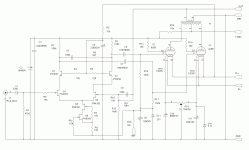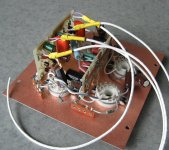A given - one, I'm always working on something or the other, and two - I can never leave well enough alone. Given those two postulates, this is a description of my latest heresy, an amp I've christened "Lil' Devil" (the color scheme will match the name, in a subdued sort of way). The form factor will be the same as my SE "Shrine" amp, 6" by 6" by 6" (tubes on top), based on a standard Hammond utility chassis. I started out with the assumption that the front end would be a differential version of the triode-cascoded JFET stage I used in the Shrine amp, using a 12AX7 instead of 6C4. Output tubes will be 6HE5/6JB5/6JC5 vertical sweep tubes, whose characteristics more closely match your usual pentode audio output tube than a typical sweep tube (the screen grid is less sensitive and has a higher voltage rating).
I had trouble spotting all the tubes in an aesthetically pleasing manner on the top deck, so I took another look at the input section and asked myself why I needed a whole triode with all the associated trappings just to cascode a JFET. The triodes went, and are replaced by a pair of Zetex 400V bipolar transistors. This frees up more space on the top deck for the output tubes, pleasingly placed.
The amp will be powered by a custom SMPS (already up and running), compounding heresy on heresy.
Current schematic (It may change a little) is shown. Pictures will follow as I get the little sucker built (input PC boards are mostly stuffed, and the chassis has almost all the holes it needs). I want to get the SMPS in place with a shield before I spot the holes for the output transformer, which will be tucked away inside the box, just like the Shrine amp. Output iron is from an old Baldwin organ or two, with ~6K P-P impedance, and a single 8 ohm output winding.
I had trouble spotting all the tubes in an aesthetically pleasing manner on the top deck, so I took another look at the input section and asked myself why I needed a whole triode with all the associated trappings just to cascode a JFET. The triodes went, and are replaced by a pair of Zetex 400V bipolar transistors. This frees up more space on the top deck for the output tubes, pleasingly placed.
The amp will be powered by a custom SMPS (already up and running), compounding heresy on heresy.
Current schematic (It may change a little) is shown. Pictures will follow as I get the little sucker built (input PC boards are mostly stuffed, and the chassis has almost all the holes it needs). I want to get the SMPS in place with a shield before I spot the holes for the output transformer, which will be tucked away inside the box, just like the Shrine amp. Output iron is from an old Baldwin organ or two, with ~6K P-P impedance, and a single 8 ohm output winding.
Attachments
It looks too complicated for me.
I suppose you refer to curcuit design, because it looks to me like everything can be placed on a 3"x3" board
I suppose you refer to curcuit design
Right, an engineer's amp. I'm not so I'll pass.
Current schematic (It may change a little) is shown.
Make R11 adjustable ? You're likely to have to tweak the feedback ratio.
Why use a high THD high-gain driver in front of the output tubes?
I don't see the high gain in the driver/phasesplitter?!
I've had nothing bet good results so far using JFETs as front ends in my amp designs. The PN4393 will probably squeeze out 10k umhos (10 milliSiemens) if you bias it real hot, but at 2 mA bias current, it's pretty docile. I cam precisely match JFETs much easier than I can with their tube counterparts, as well.
Wip
Here is a piccture of the top deck (underside) of the amp, with most of the wiring finished. Tasks remaining are to wire the screens and the balance pots. The top deck is made of single-sided 2oz FR-4 circuit board, with the unclad side facing up (it'll take paint better), and the copper clad side serving as ground plane for the amp.
Here is a piccture of the top deck (underside) of the amp, with most of the wiring finished. Tasks remaining are to wire the screens and the balance pots. The top deck is made of single-sided 2oz FR-4 circuit board, with the unclad side facing up (it'll take paint better), and the copper clad side serving as ground plane for the amp.
Attachments
Last edited:
I don't see the high gain in the driver/phasesplitter?!
It's a cascode of JFETs and BJTs. BJTs are naturally very high gain devices. It makes them highly useful in certain applications such as solid state amps where you want to drive the NFB way up, or use small collector loads to give increased bandwidths, or as CCSs.
No telling what that front end will sound like, though it's used frequently in all solid state designs where it works quite well.
Another one of those cases where you probably won't know until you try.
I have a P-P amp using JFETs cascoded with triodes that works very nicely - you can see it by checking the "Kingfisher" thread. This one takes the front end to its logical conclusion - why use the triodes just to cascode the JFETs? I needed the space on the top deck anyway...
Last edited:
Amp is proceeding at a slow and steady pace. Just about all the wiring is in place on the top deck and just about all the holes are in the case, except for the pilot light, which will be a deep red first-generation GaAsP LED. The wiring harness from the SMPS to amp top deck is done, and needs to be integrated with the top deck. The bottom plate needs some ventilation holes.
Tasks remaining (not an exhaustive list)
1) Finish top deck wiring, mate with output XFMRS and in/out connectors, and bring up amp with bench supplies to match output tubes, verify bias levels and tweak compensation.
2) Modify SMPS top shield to accept AC in/DC out connectors, perform EMI scan with resistive load with supply mounted in case with shield.
3) After amp is working, disassemble to paint case and top deck.
4) Reassemble, retest, and wreak havoc...
Tasks remaining (not an exhaustive list)
1) Finish top deck wiring, mate with output XFMRS and in/out connectors, and bring up amp with bench supplies to match output tubes, verify bias levels and tweak compensation.
2) Modify SMPS top shield to accept AC in/DC out connectors, perform EMI scan with resistive load with supply mounted in case with shield.
3) After amp is working, disassemble to paint case and top deck.
4) Reassemble, retest, and wreak havoc...
Last edited:
This project has been chugging along quietly in the background, taking back seat at times to some wild-a** ideas. Case and top panel are assembled,and the wiring harnesses are finished. Next step is probably integrating the top deck stuff with output transformers and connectors so I can bring up the amp in a decorous fashion with bench supplies. I'll post pictures when appropriate, but the amp is going to look a bit strange, with four stubby little compactrons sprouting out of the top of a 6" cube.
This amp has been sitting around in the basement waiting for me to finish it. In the meantime I've realized that the current design does not address blocking distortion, and have come up with a somewhat different front end that direct couples to the output stage and gets rid of the problem (still sand state, though). I'll post some schematics when I get something working. Though the approach looks straightforward, it's always the actual implementation (and fitting it into a 6" cube) that's the rub. It will also require a different SMPS design, and I'll have to come up with that as well. More later...
This amp will represent another in a series of approaches to realize a push-pull design that addresses blocking distortion and imperfect matching between output tubes. When all the dust settles and I get things finished, I think there will be three or four alternative approaches. All have some sand in them, and I am defiantly unapologetic about it.
This amp will represent another in a series of approaches to realize a push-pull design that addresses blocking distortion and imperfect matching between output tubes. When all the dust settles and I get things finished, I think there will be three or four alternative approaches. All have some sand in them, and I am defiantly unapologetic about it.
- Status
- This old topic is closed. If you want to reopen this topic, contact a moderator using the "Report Post" button.
- Home
- Amplifiers
- Tubes / Valves
- Lil' Devil P-P Amp


